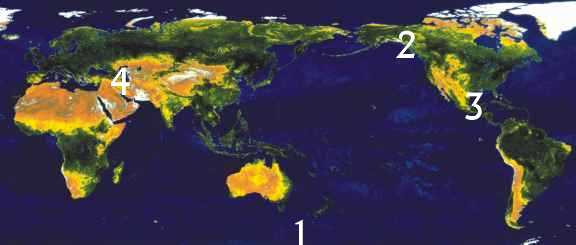
| Geotimes Home | Calendar | Classifieds | Subscribe | Advertise |
| Geotimes
Published by the American Geological Institute |
January
2001
Newsmagazine of the Earth Sciences |

Recent analysis of satellite imagery shows the Ninnis Glacier Tongue broke away from the coast of King George V Land, situated on the eastern coast of the Antarctic Ice Sheet south of Tasmania.
Rob Massom, polar research scientist at the Antarctic Cooperative Research
Centre at the University of Tasmania, Australia, discovered the February
2000 breakout. “I was looking at sea ice distribution and noticed something
unusual in the
satellite images,” Massom says. “The coastline looked very different
than it had in previous images.”
As with the large iceberg B-15, which broke away from the Ross Ice Shelf in March, it is unlikely that the Ninnis calving was connected to global warming. “The disintegration is likely to be the consequence of a natural progression of events that periodically occur in floating glacier tongues around the margin of the Antarctic Ice Sheet,” Massom says. Iceberg B-15 had formed from glacier ice moving off the Antarctic continent that calved along pre-existing cracks in the Ross Ice Shelf. Scientists are still carefully watching the course of the larger B-15 iceberg. Nearly 300 kilometers long and 40 kilometers wide, it was one of the largest icebergs ever seen at the time of its formation. Since then, it has broken into two main icebergs and other smaller ones, including B-17, which probably formed when B-15 crashed into the ice shelf.
On Dec. 5, researchers fated the fast moving Columbia Glacier in Alaska to the sea. The glacier moves at a rate of up to 34 meters a day. At that pace, it will retreat as far as 25 kilometers up the valley it has carved out or thin to a breaking point, says Tad Pfeffer of the University of Colorado at Boulder. “It should be quite a spectacular sight in the not too distant future,” he says.
The glacier, which stretches from the Chugach Mountains into Prince Williams Sound near Valdez, has retreated about 12 kilometers since 1982. Pfeffer and colleagues measured the glacier to currently stretch 54 kilometers long, 5 kilometers wide and 1,000 meters thick in some places.
A moderate earthquake rocked Mexico City on the morning of Dec. 1, hours before the inauguration of President-Elect Vicente Fox. Towering over the capital, Popocatépetl also came to attention, spewing out a plume of ash.
There were no immediate reports of damage or injury from the 8:07 a.m. earthquake, which was centered on the Pacific coast roughly 350 kilometers west of the capital, where tall buildings swayed slightly. The USGS National Earthquake Information Center calculated the magnitude as 5.0. Mexico’s National Seismological Service put it at 5.5.
At dawn, the 5,366-meter Popocatépetl sent out a 2-kilometer plume of ash and gas. Mexico’s National Center for the Prevention of Disasters recorded tremors from the volcano and maintained a standing warning for people to stay at least six miles away from the volcano, which is some 65 kilometers southeast of Mexico City.
An earthquake with a preliminary magnitude of
7.2 rumbled Turkmenistan on Dec. 6, with no immediate reports of deaths
or injuries. The U.S. Geological Survey’s National Earthquake Information
Center put the quake’s epicenter at 39.69 degrees north latitude, 54.86
degrees east longitude in the southern part of the Caspian Sea, off Turkmenistan’s
west coast, about 300 miles from the capital, Ashgabat. The quake was felt
both in Ashgabat and in Baku, the capital of Azerbaijan, where an early
quake measuring a magnitude of 6.3 killed at least three people on Nov.
25.
 |
Geotimes Home | AGI Home | Information Services | Geoscience Education | Public Policy | Programs | Publications | Careers |